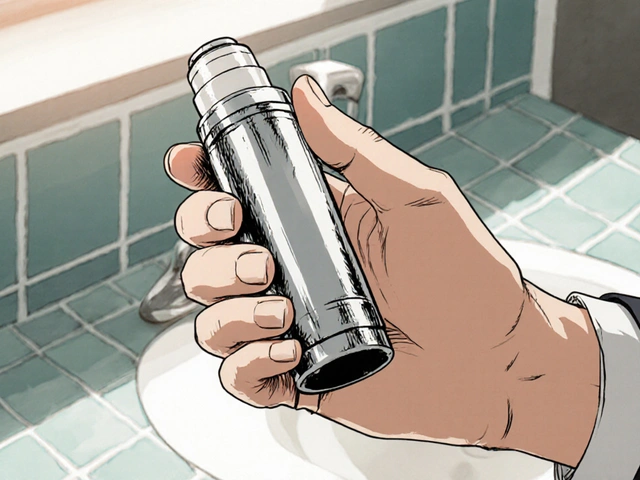Medication Selector Tool
Select your primary condition
Do you have any of these comorbidities?
Which side effects are most important for you to avoid?
When doctors need to tame high blood pressure or calm withdrawal symptoms, they often reach for Clonidine is a central alpha‑2 adrenergic agonist that lowers sympathetic nerve activity, making it useful for hypertension, ADHD, and opioid withdrawal management. Clonidine comparison tools help patients and clinicians see if a different drug might fit better. Below we line up Clonidine against the most common alternatives, breaking down how they work, when they’re prescribed, and what side‑effects to expect.
Key Takeaways
- Clonidine lowers blood pressure by reducing central sympathetic outflow; it’s also approved for ADHD and withdrawal.
- Guanfacine offers a similar mechanism with a smoother side‑effect profile for ADHD.
- Older drugs like Methyldopa work via different pathways and are rarely first‑line today.
- Beta‑blockers such as Propranolol are useful when heart‑rate control is also needed.
- Choosing the right agent depends on the primary condition, comorbidities, and tolerance to side‑effects.
How Clonidine Works
Clonidine binds to alpha‑2 receptors in the brainstem, turning down the release of norepinephrine. The net effect is a drop in heart‑rate and vascular resistance, which translates into lower blood pressure. For ADHD, the drug’s calming influence improves attention and reduces impulsivity. When used during opioid detox, it eases the surge of sympathetic activity that causes tremors and sweating.
Overview of Common Alternatives
The market offers several drugs that target similar symptoms, each with its own mechanism.
Guanfacine is a selective alpha‑2A agonist that primarily treats ADHD and can be used for hypertension in low doses. It tends to cause less dry mouth than Clonidine.
Methyldopa works by converting to alpha‑methylnorepinephrine, a false transmitter that reduces sympathetic tone. It’s an older choice for pregnancy‑related hypertension but has a higher risk of liver toxicity.
Labetalol combines alpha‑ and beta‑blocking activity, making it useful for acute hypertensive crises where both heart‑rate and vascular resistance need control.
Propranolol is a non‑selective beta‑blocker that slows heart‑rate and reduces cardiac output. It’s often chosen for performance anxiety and migraine prophylaxis, not just blood pressure.
Prazosin blocks alpha‑1 receptors, causing vasodilation. It’s popular for treating nocturnal hypertension and PTSD‑related nightmares.
Beta blockers as a class (Beta blocker includes agents like Atenolol and Metoprolol) focus on heart‑rate reduction, which can complement or replace Clonidine depending on the patient’s cardiac profile.
Side‑Effect Profiles at a Glance
Every medication brings trade‑offs. Clonidine’s most common complaints are dry mouth, sedation, and rebound hypertension if stopped abruptly. Guanfacine often causes fatigue but less Dry mouth. Methyldopa can lead to hemolytic anemia and liver enzyme elevations. Labetalol may produce bronchospasm in asthmatics because of its beta‑blocking component. Propranolol can cause bronchoconstriction and depressive symptoms. Prazosin’s main downside is first‑dose orthostatic hypotension, which can be mitigated by low‑starting doses.

Dosage and Administration
Clonidine is typically started at 0.1 mg twice daily and titrated to 0.3 mg three times daily for hypertension. For ADHD, a low dose of 0.05 mg at bedtime is common. Guanfacine XR starts at 1 mg daily, with a maximum of 4 mg. Methyldopa begins at 250 mg 2‑3 times daily, while Labetalol can be given intravenously (20 mg) for emergencies or orally (100‑400 mg) for chronic control. Propranolol dosing ranges from 40 mg twice daily (cardiac) to 10 mg for anxiety. Prazosin starts at 1 mg at bedtime, often increased to 5 mg.
Decision Criteria: When to Pick Clonidine vs an Alternative
- Primary indication: Choose Clonidine for combined hypertension + ADHD or opioid withdrawal; pick Guanfacine if ADHD is the sole concern.
- Comorbid conditions: If the patient has asthma, avoid beta‑blockers like Propranolol; consider Labetalol or Clonidine.
- Side‑effect tolerance: Patients prone to dry mouth may prefer Guanfacine; those who can handle sedation might stay on Clonidine.
- Pregnancy status: Methyldopa remains the safest category B option for pregnant hypertensives.
- Renal or hepatic function: Clonidine is largely metabolized hepatically; dose adjustments are minimal in renal failure.
Comparison Table
| Drug | Mechanism | Key Uses | Typical Dose Range | Major Side‑Effects | Contra‑indications |
|---|---|---|---|---|---|
| Clonidine | Central alpha‑2 agonist | Hypertension, ADHD, opioid withdrawal | 0.1‑0.3 mg 2‑3×/day (HTN); 0.05‑0.2 mg QHS (ADHD) | Dry mouth, sedation, rebound HTN | Severe bradycardia, recent MI |
| Guanfacine | Selective alpha‑2A agonist | ADHD, mild hypertension | 1‑4 mg daily (XR) | Fatigue, hypotension, dry mouth (less) | Severe cardiac conduction disorders |
| Methyldopa | Converted to alpha‑methylnorepinephrine (false transmitter) | Pregnancy‑related hypertension | 250‑500 mg 2‑3×/day | Liver toxicity, hemolytic anemia | Liver disease, pheochromocytoma |
| Labetalol | Combined alpha‑1 and beta‑blockade | Acute hypertensive emergencies | IV 20‑80 mg; PO 100‑400 mg BID | Bronchospasm, fatigue, dizziness | Asthma, AV block |
| Propranolol | Non‑selective beta‑blocker | Hypertension, anxiety, migraine prophylaxis | 40‑80 mg BID | Bronchoconstriction, depression | Asthma, severe bradycardia |
| Prazosin | Selective alpha‑1 blocker | Nocturnal hypertension, PTSD nightmares | 1‑5 mg at bedtime | First‑dose hypotension, dizziness | Severe hypotension, cardiac shock |
Practical Tips for Switching or Stopping Clonidine
- Never quit abruptly; taper by 0.1 mg every 3‑5 days to avoid rebound hypertension.
- If moving to Guanfacine, overlap for 48 hours at half the Guanfacine dose.
- Monitor blood pressure and heart‑rate daily during any change.
- Educate patients about dry‑mouth remedies-sugar‑free gum works well.
- Check liver function tests if Methyldopa is selected for a pregnant patient.
Frequently Asked Questions
What conditions is Clonidine approved to treat?
Clonidine is FDA‑approved for hypertension, ADHD (as an adjunct), and to ease symptoms during opioid withdrawal.
How does Clonidine differ from Guanfacine?
Both act on central alpha‑2 receptors, but Guanfacine is more selective for the α2A subtype, giving a milder side‑effect profile for ADHD and less impact on blood pressure.
Can I use Clonidine if I have asthma?
Yes, Clonidine does not block beta receptors, so it’s safer than non‑selective beta‑blockers. However, consult a doctor if you have severe respiratory disease.
What is rebound hypertension and how to prevent it?
Rebound hypertension is a rapid rise in blood pressure after abruptly stopping Clonidine. Prevent it by tapering the dose gradually and, if needed, substituting a short‑acting antihypertensive during the taper.
Is Clonidine safe for long‑term use?
Long‑term use is generally safe when monitored. Periodic checks of blood pressure, heart‑rate, and liver function are recommended, especially if combined with other antihypertensives.
When would Methyldopa be preferred over Clonidine?
Methyldopa is preferred in pregnancy because it is classified as Category B and has a long safety record for fetal exposure, whereas Clonidine is Category C.
Bottom Line
Clonidine remains a versatile tool, especially when blood‑pressure control must be combined with ADHD or withdrawal management. Yet alternatives like Guanfacine, Labetalol, and Propranolol each bring unique strengths. By weighing the primary indication, comorbidities, and side‑effect tolerance, clinicians can pick the drug that fits the patient best.






Natalie Morgan
October 20, 2025 at 22:12
Clonidine’s central alpha‑2 action makes it a versatile option when hypertension co‑exists with ADHD or withdrawal management.
Its ability to reduce sympathetic outflow also helps patients who experience tremors during opioid detox.